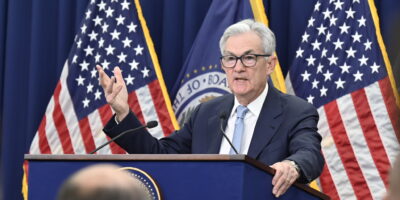Money: East vs. West
A country’s money supply is made up of two distinct components. State money — the monetary liabilities of a central bank (typically referred to as base, or high-powered, money) — is one element, and is by far the smallest component of the money supply. The second and most important component of the money supply is bank money. This is the money (deposit liabilities) that is created by the banking system, broadly defined.
Changes in the money supply are a dominant force in the economy — a force that determines changes in prices and in economic activity, measured by nominal GDP. Accordingly, we must pay the most careful and anxious attention to movements in a country’s total money supply, as well as to the movements in its components (state and bank money).
When it comes to forecasting economic activity, most people fail in their diagnoses because they ignore money. That said, those who do pay attention to money often come up short, because they focus exclusively on central banks and developments in state money, at the expense of the allimportant bank-money component.
A review of the accompanying money-supply chart for the U.S. tells the economic story. The money supply has been growing at a rate lower than the trend rate, resulting in a money supply “deficiency”. In consequence, the U.S. has been in a growth recession — positive, but weak, economic activity, accompanied by subdued inflationary pressures.
But, most people believe that monetary policy has been ultra-loose since the collapse of Lehman Brothers in September 2008. Well, by standard accounts, it has been — the quantity of state money has almost tripled since September 2008. When looked at through the proper lens, however, the picture is quite different.
The policies that affect bank money — like the Basel III capital requirements and the Dodd-Frank financial regulatory legislation, for example — have forced banks to deleverage and contract their lending. Indeed, monetary policy, as it affects bank money, has been tight, and the quantity of bank money in the U.S. has fallen by 9.54% since Lehman Brothers collapsed.
With bank money making up 94% of the total money supply at the onset of the crisis, it is easy to see why its decline has been difficult for the producers of state money (the Fed) to offset. Not surprisingly, the explosion in state money has failed to overcome the decline in bank money.
In consequence, and contrary to the conventional view, the overall monetary stance in the U.S. — thanks largely to draconian bank regulations — has been tight since the financial crisis began. This is not the kind of medicine any sane doctor would prescribe in the middle of an economic slump. What can be done? The first and most obvious step would be to free the U.S. banking system of the vise-like regulations contained in Dodd-Frank and Basel III. But, this will take time. More immediately, the government could engage in debt market operations.
These debt market operations can take many forms. And, the most prudent type would be one which directly increases the money supply, without increasing the level of U.S. debt. The government would first borrow from commercial banks. In exchange for short-dated government paper, the banks would credit the deposit balance of the government. The government would then use its bank deposits to purchase outstanding long-dated government bonds from the public.
These transactions would add to the public’s bank deposits and directly to the money supply, because bank deposits in the name of private persons and entities are money. So, the quantity of money would be directly increased by this debt market operation, and an equivalent amount of long-dated government debt would be reduced — literally eliminated. Since there is little point in the government holding claims on itself, the government would simply cancel the claims.
Of course, the amount of short-dated government debt would increase when the government initially borrows from the commercial banks. Accordingly, the debt market operation would leave the government’s total net debt unchanged, but it would change the composition of the government’s debt, leaving it with a shorter average duration.
With the type of debt market operation described above, the government, commercial banks, and the public would all be participants in increasing the total money supply, via an increase in bank money. Accordingly, the money supply would increase, but without central bank action or a change in the quantity of state money.
The government could also conduct its debt market operations by borrowing from the central bank, rather than from commercial banks. But, in this case, both the quantity of state money and bank money would increase — a fundamental difference, when compared to the initial example.
Alternatively, the central bank could engage directly in debt market operations, and several have done so in recent so-called quantitative easing operations (QE). But, in this case, the long-dated bonds purchased by the central bank would end up on the central bank’s balance sheet. The debt would not be canceled out, as it would be if the government was to conduct debt market operations.
It is this fact that defines one of the fundamental differences between debt market operations conducted by a central bank and those conducted by a government. A central bank engaged in debt market operations would be left with holdings of long-dated government debt, and would be exposed to interest-rate risk on those securities — it could incur large accounting losses if interest rates were to rise. This would not be the case if the government conducted debt market operations.
If we move from the U.S. to Europe, the money supply picture generally looks even grimmer, with most countries experiencing money supply deficiencies. Just take a look at the accompanying chart for Greece. As night follows day, the grim reaper follows a collapse in the money supply. The Greek GDP continues to implode, declining by 6.2% in the second quarter of 2012, relative to the same period in 2011.
When we move east and arrive in Asia, things start looking up. Although plenty of doomsters have pontificated about the fate of the biggest economy in Asia, the Chinese money supply picture might just prove them wrong. Indeed, it looks like the Middle Kingdom will continue to be the region’s engine for a bit longer than predicted by the doomsters.
Even Asia’s second largest economy, Japan, is functioning rather well, from a money supply point of view. The zombie banks, which refused to make loans in the 1990s, seem to be in hiding. Like China, Japan has a money supply “surplus”, not a deficiency.
And for all the negative news coming out of the subcontinent, India’s money supply is also in surplus. Moving to Australia and South Korea, the total money supply, for each, is growing at a trend rate.
We end with Indonesia. The growth in both state and bank money here have pushed the total money supply into a surplus of 13.6%. This explains why Indonesia continues to defy the odds.
While the vise of bank regulations has played havoc with bank money in the U.S., and in most of Europe, Asia has rejected this type of government-mandated money squeeze. In consequence, bank money, and the total money supply growth, have remained in good health. Those who anticipate a rapid end to the Asian good news story might just have to wait longer than expected for the curtain to close.
Read the original article here










